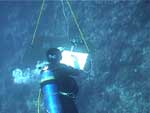NOWRAMP
2002
 Update
from the Townsend Cromwell
(9/11/02)
Update
from the Townsend Cromwell
(9/11/02)
by
Stephani Holzwarth
Sept.
11, 2002. We were at sea on the Cromwell a year ago when
planes crashed into the World Trade Center, the Pentagon,
and a field in Pennsylvania. I still remember the stunned
silence in the galley after Bruce read the message. Everyone
just stared at him, the ship rocked and rolled in the waves,
plodding steadily ahead, and none of us knew what to think.
By the time we pulled back into port, the world had changed.
Out here in the remote waters of the atolls life seems to
be buffered from war and politics, though in reality ocean
ecosystems are very much affected by decisions made by human
governments. Luckily, the fish out here don't know that
yet, and today I watched parrotfish and butterflyfish, jacks,
wrasses, surgeons, and goatfish swimming  about
their reef business. Rusty and I completed our first tow
of the trip among the sheltered patch reefs just inside
the northern barrier reef. The habitat was nothing spectacular-
but healthy enough, and full of variety. We towed past fields
of rubble, punctuated with volkswagen sized humps of rock
covered with buttery yellow swatches of coral (Porites lobata).
We towed through a maze of shallow patch reefs, where a
pretty little whitetip reef shark swam out of her hole a
few feet in front of me. A shiny squirrelfish poked his
head out of a cave as we flew by. A handful of papio followed
us for awhile.
about
their reef business. Rusty and I completed our first tow
of the trip among the sheltered patch reefs just inside
the northern barrier reef. The habitat was nothing spectacular-
but healthy enough, and full of variety. We towed past fields
of rubble, punctuated with volkswagen sized humps of rock
covered with buttery yellow swatches of coral (Porites lobata).
We towed through a maze of shallow patch reefs, where a
pretty little whitetip reef shark swam out of her hole a
few feet in front of me. A shiny squirrelfish poked his
head out of a cave as we flew by. A handful of papio followed
us for awhile.
 It
was a full day. Before towing we installed 2 oceanographic
instruments. The first was a CREWS buoy, which stands for
Coral Reef Early Warning System, and measures sunlight levels
above and below water, water and air temperature, salinity,
wind speed and direction, and atmospheric pressure. It looks
like a floating orange spaceship with all the antennas and
sensors coming off the top. The second instrument was a
Seabird temperature recorder that we attached directly to
the reef in about 10 feet of water. Coral is sensitive to
changes in water temperature and if it gets too warm the
coral bleaches and will die unless the water cools off again.
You can see why "global warming" could be a real
problem for coral reefs...
It
was a full day. Before towing we installed 2 oceanographic
instruments. The first was a CREWS buoy, which stands for
Coral Reef Early Warning System, and measures sunlight levels
above and below water, water and air temperature, salinity,
wind speed and direction, and atmospheric pressure. It looks
like a floating orange spaceship with all the antennas and
sensors coming off the top. The second instrument was a
Seabird temperature recorder that we attached directly to
the reef in about 10 feet of water. Coral is sensitive to
changes in water temperature and if it gets too warm the
coral bleaches and will die unless the water cools off again.
You can see why "global warming" could be a real
problem for coral reefs...
<<Journals
Home